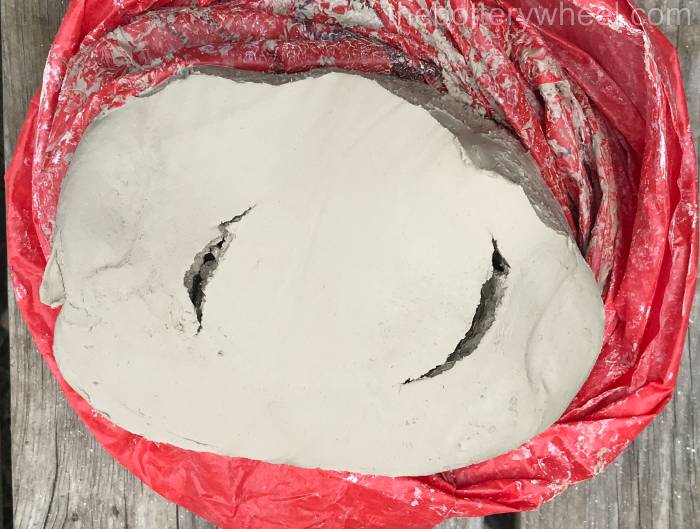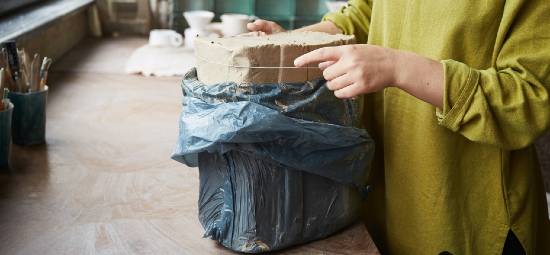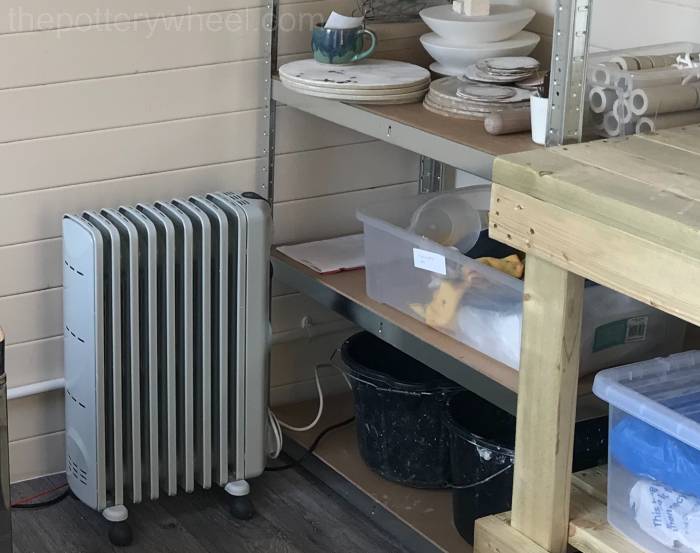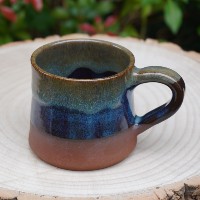Your cart is currently empty!
Frozen Clay and Glaze – Can it Be Used and What to Do?
Published:
Last Updated:

Affiliate Disclaimer
As an affiliate, we may earn a commission from qualifying purchases. We get commissions for purchases made through links on this website from Amazon and other third parties.
Clay and glaze both have quite a high water content and when they are stored in sub-zero temperatures, they can both become frozen solid. But what can you do with frozen clay and glaze? Are they permanently damaged or can they be revived?
The good news is that frozen clay and glaze can both be brought back to a usable state and won’t have been damaged from the freezing process.
This article covers what happens to clay and glaze when they freeze and how to revive it.

Frozen Clay
Clay is made up of tiny particles layered together, held in place by moisture. Water is about 30-40% of moist clay and it’s what makes the clay workable.
When the temperatures reach freezing point, the water crystallizes and becomes icy. Once the water freezes, it separates the clay particles and expands, causing the clay to split or crack. This is what a block of clay can look like once it has been frozen.

However, as we shall see later in the article, this does not mean that the clay is damaged. Upon restoration, the clay can be just as good if not better than it was before. It disintegrates once it thaws, but it can be recycled. After all, clay has undergone many years of erosion, freezing, and thawing in its natural setting.
Can You Use Clay or Glaze That Has Been Frozen?
It’s a common misconception that once clay or glaze is frozen, it is permanently damaged. Some even toss it away. However, this need not be the case. While you cannot use the clay while it is hard and cracked, there are ways to bring it back to the same condition as before getting frozen, if not better.
So, to answer this question, yes, you can use clay or glaze that has been frozen. You simply have to thaw and wedge them back into usable condition.
As we have already established, usable clay and glaze are those that are mixed well with moisture. The water that makes clay workable is known as free water. Therefore, when clay becomes hard and cracks due to cold temperatures, it is the free water that freezes. This is to say that no chemical changes take place when clay or glazes freezes.
What changes in frozen clay is the physical distribution of the moisture in the clay, which is more or less the same phenomenon as when fluffy and dry snow falls to the ground only to become solid in a short while. In other words, frozen clay and glaze can be reversed back into a workable form.
How To Restore Frozen Clay?
Thawing out frozen clay and glaze is the first step towards restoring them. Thawing happens when the clay and glaze are at a temperature warm enough that the frozen water crystals begin to melt, and the clay starts softening up.
You might find that once the clay is thawed, it has an uneven consistency. Some parts of the clay might feel tough and other parts of the clay might be mushy.
If the clay feels a bit water-logged and mushy throughout, you might need to take steps to draw out some of the excess moisture.
You can do this by spreading mushy, overly soft clay on a plaster slab. The excess water will be absorbed by the plaster slab and bring the clay back to a firmer consistency. You can find out how to make a plaster slab for clay here.
If you use a plaster slab, be sure to check on the clay regularly. Plaster absorbs moisture quickly and it’s easy for clay to become overly dry on plaster. You can flip the moist clay over on the slab to make sure that it doesn’t dry out too much on one side.
Once the clay is firmer, you will need to wedge it again before you use it.
Alternatively, it may be that the clay is not too moist, but that it has an uneven consistency. If that’s the case, then you don’t need to put the clay on a plaster bat.
Instead, you can go straight to wedging the clay to get rid of any air pockets that might have formed in the clay when it froze. Wedging will also help to even out the consistency of the clay so that it is useable once again.

How To Restore Frozen Glaze?
The best way to restore frozen glaze is to allow it to thaw gradually at room temperature. Once it has frozen, stir the glaze thoroughly to mix up the ingredients so that they are blended evenly.
How To Prevent Clay and Glaze from Freezing
The best way to keep clay and glaze from freezing is to store them in a warm environment. This could be a location with controlled temperatures all year long, especially during winter.
However, you may well not have the space to store your clay in your home for the whole of the winter. So here are a few alternatives:
- Use a Small Heater:
I use a small plug-in wall heater in my pottery shed over the wintertime. It’s an electric oil heater like this one, which is relatively cheap to run. However, if I put it on a low setting, it will bring the temperature up in my pottery shed to just above freezing temperature. It’s still cold in the shed, but the heater takes the edge off and makes it just warm enough to prevent clay and glaze from freezing.

- Use Pallets and Tarpaulin:
Put pallets around the clay and cover them with tarpaulin. This will create a bit of an air trap between the clay and the tarpaulin and can keep the frost off your clay. - Use of old blankets: Try covering your clay and glaze with old blankets. If the temperature doesn’t drop too far below freezing, this can sometimes be an effective way to stop clay and glaze from freezing for a short period of time.
If you live in a region that gets extremely cold for long periods, the only way to stop clay and glaze from becoming frozen is to move it into a heated space.
At What Temperature Do Clay and Glaze Freeze?
Since clay is made up of free water, it follows that clay will freeze at the freezing point of water, which is 32F (0C). It is at this temperature that water starts separating from clay particles to form crystals.
On the other hand, glaze has salts in its formula, which lowers its freezing point. Thus, glaze starts freezing at temperatures lower than 32⁰F. The contaminates in glaze start freezing at 28⁰F. To freeze solid, the temperature has to be below 28⁰F (-2C).

Visit The Pottery Wheel Store
Fancy treating yourself to some homemade pottery? Looking for a unique gift? Check out my handmade pottery store…
Final Thoughts
When exposed to extremely cold temperatures, clay and glaze will freeze. Typically, clay freezes at the freezing point of water, which is 32⁰F. Glaze, due to the contaminants in its formula, requires a lower temperature to start freezing.
While you can’t use frozen clay and glaze in their solid frozen state, it does not mean they are damaged, so maybe hold off tossing them. They are restorable and can get back into workable states when they thaw out. Frozen glaze is easier to restore than frozen clay.



